 |
 |
 |
| |
RVR & Ribavirin Dose Predict SVR
|
| |
| |
(from Jules: This study underscores previously reported key information, that achieving a Rapid Viral Response (RVR) at week 4 (undetectable HCV RNA) predicts a high likelihood of achieving an SVR (cure) and ribavirin dosing, as well as peginterferon drug levels matter, that is -- adherence [see Figure 3].)
Baseline and on-treatment factors associated with high rates of sustained virological response in patients with and without cirrhosis following treatment with peginterferon alfa-2a (40KD) (PEGASYS) plus ribavirin (COPEGUS)
Reported by Jules Levin
43rd EASL
April 23-27, 2008
Savino Bruno,1 Stephanos J Hadziyannis,2 Mitchell Shiffman,3 Diethelm Messinger,4 Patrick Marcellin5
1AO Fatebenefratelli e Oftalmico, Milan, Italy, 2Henry Dunant Hospital, Athens, Greece, 3Virginia Commonwealth University Medical Center, Virginia, USA, 4IST, Mannheim, Germany, 5Service d'Hepatologie and INSERM U773/CRB3, H™pital Beaujon, Clichy, France
AUTHOR CONCLUSIONS
Patients with less extensive fibrosis at baseline had consistently higher overall SVR rates in comparison with patients with advanced fibrosis (bridging fibrosis or cirrhosis). However, in this latter group, SVR rates are high in patients with favourable baseline and on-treatment prognostic factors.
Treatment completion and/or discontinuation due to adverse effects seemed not to be affected by the presence of advanced fibrosis.
Consistent with analyses reported in other, less selected patient populations,[4] high SVR rates can be achieved in patients with bridging fibrosis or cirrhosis who achieve an RVR a complete EVR and who maintain a high cumulative exposure to peginterferon alfa-2a (40KD) and ribavirin. ["When on-treatment factors were included in the model, the most important predictors were achievement of an RVR or complete EVR and high cumulative exposure to ribavirin (≥60%)"]
Patients with and without advanced fibrosis who achieve an RVR have similar SVR rates when treated for 24 weeks (genotype 2 or 3) or 48 weeks (genotype 1 or 4).
Of major importance, these results demonstrate that abbreviated regimens should be avoided in genotype 2 or 3 patients with advanced fibrosis.
Introduction
Patients with chronic hepatitis C and advanced hepatic fibrosis have lower sustained virological response (SVR) rates after treatment with pegylated interferon plus ribavirin than patients with less advanced liver disease.
Identifying specific subsets of patients with advanced fibrosis with a higher probability of achieving an SVR would be of practical value to clinicians.
The clinical trial programme for peginterferon alfa-2a (40KD) (PEGASYS) plus ribavirin (COPEGUS) included patients with compensated cirrhosis, and thus represents a large pooled database of patients with advanced fibrosis.
The objective of this analysis is to determine the predictive values of baseline and on treatment factors associated with SVR in patients with advanced fibrosis in three large phase III studies.[1-3]
All HCV genotype 1 or 4 patients treated with peginterferon alfa-2a (40KD) 180 _g/week plus ribavirin 1000 or 1200 mg/day for 48 weeks.[1,2]
All HCV genotype 2 or 3 patients treated with peginterferon alfa-2a (40KD) 180 _g/week plus ribavirin 800 mg/day for 16 or 24 weeks.[2,3]
Rapid virological response (RVR) was defined as undetectable HCV RNA (<50 IU/mL) at week 4 during treatment.
Complete early virological response (cEVR) was defined as undetectable HCV RNA (<50 IU/mL) at week 12 during treatment.
Partial early virological response (pEVR) was defined as a 2 log10 drop of HCV RNA (to baseline) at week 12 during treatment.
SVR was defined as undetectable HCV RNA (<50 IU/mL) at the end of a 24-week untreated follow-up period in all studies.
Multiple logistic regression (MLR) analyses were conducted to identify significant baseline and on-treatment factors predictive of SVR in patients with advanced fibrosis. Odds ratios (OR) and 95% confidence intervals (95% CI) were calculated for factors retained in the final models.
RESULTS
The study population comprised 341 patients infected with HCV genotype 1 or 4, 99 (29%) of whom had advanced fibrosis, and 1547 patients infected with HCV genotype 2 or 3, 380 (25%) of whom had advanced fibrosis.
There were significant differences at baseline between patients with/without bridging fibrosis/cirrhosis (Table 1).
SVR rates were consistently and significantly lower in patients with than without advanced fibrosis, regardless of genotype or treatment duration (Figure 1). Lower rates of SVR were obtained in the subset of patients with complete cirrhosis (Metavir F4, Knodell F4 or Ishak F5 or F6): 33% in genotype 1 patients (n=36), 57% in genotype 2/3 patients treated for 24 weeks (n=70) and 48% in genotype 2/3 patients treated for 16 weeks (n=82). Among patients with genotype 2 or 3 infection and with advanced fibrosis, the rate of SVR was significantly higher in those treated for 24 weeks as compared with 16 weeks (59.8% vs 48.2%; p=0.0231; Figure 1).
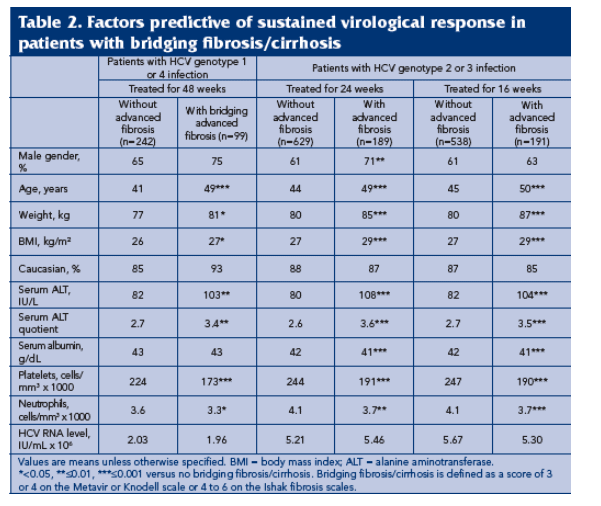
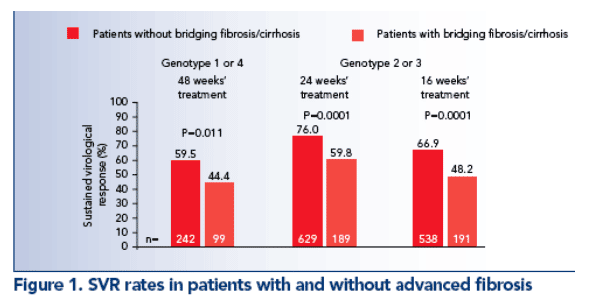
Early on-treatment virological responses were predictive of SVR (Figure 2).
- RVR portended an SVR regardless of genotype or treatment duration (70 95%), although rates of SVR were somewhat lower among patients with advanced fibrosis (70-82% vs 82%-95% in those without advanced fibrosis).
- cEVR was associated with high rates of SVR (68-72%), irrespective of fibrosis stage in genotype 1/4 patients. In genotype 2/3 patients, cEVR was associated with a high rate of SVR among those without advanced fibrosis treated for 24 weeks (65%). The SVR rate was lower in genotype 2/3 patients with advanced fibrosis treated for 24 weeks and in those treated for 16 weeks, regardless of histology.
-- Among patients with pEVR, few genotype 1/4 patients (23-30%) and no genotype 2/3 patients achieved an SVR.

High SVR rates were achieved in those patients with advanced fibrosis who had favourable characteristics, including age <40 years, serum HCV RNA level <400 000 IU/mL and ≥80% exposure to study drugs (Figure 3). The general superiority of 24 weeks of treatment compared with 16 weeks of treatment is apparent in genotype 2 or 3 patients with unfavourable characteristics.
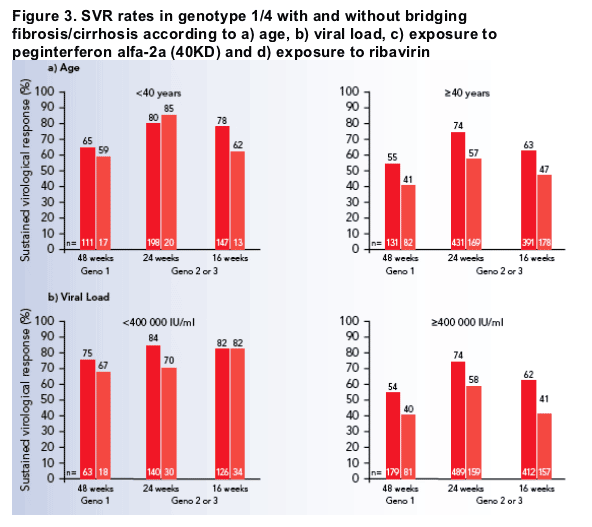
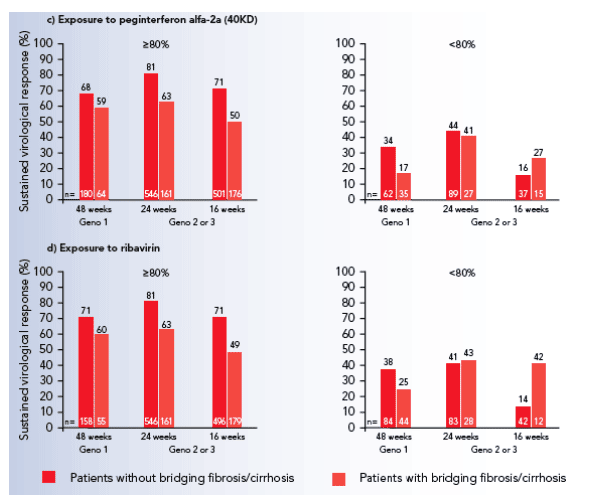
Baseline and on-treatment factors predictive of SVR in the MLR analysis are presented in Table 2. When on-treatment factors were included in the model, the most important predictors were achievement of an RVR or complete EVRand high cumulative exposure to ribavirin (≥60%).
When the model was restricted to patients that completed treatment, cumulative ribavirin exposure was still a significant predictor of SVR in genotype 1 and 4 patients (OR 21.464, 95% CI 1.833-244.698; p=0.0135). This was not true for genotype 2 and 3 patients.
The presence of advanced fibrosis did not influence the rate of treatment completion (75.8% vs 80.6% in patients without advanced fibrosis) or discontinuation due to adverse effects (11.1% vs 12.0%).
The proportion of patients with haemoglobin <8.5 g/dL was similar in patients with or without advanced fibrosis (2.0% vs 1.7%, respectively) as was the proportion of patients with a neutrophil count <0.5 x 103/μL (3.0% vs. 4.1%). However, a higher proportion of patients with advanced fibrosis had platelet counts ≦50 000/μL during treatment (9.1% vs 2.1% in patients without advanced fibrosis).

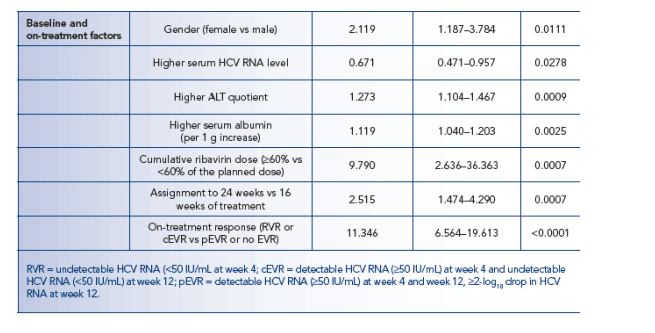
|
| |
|
 |
 |
|
|